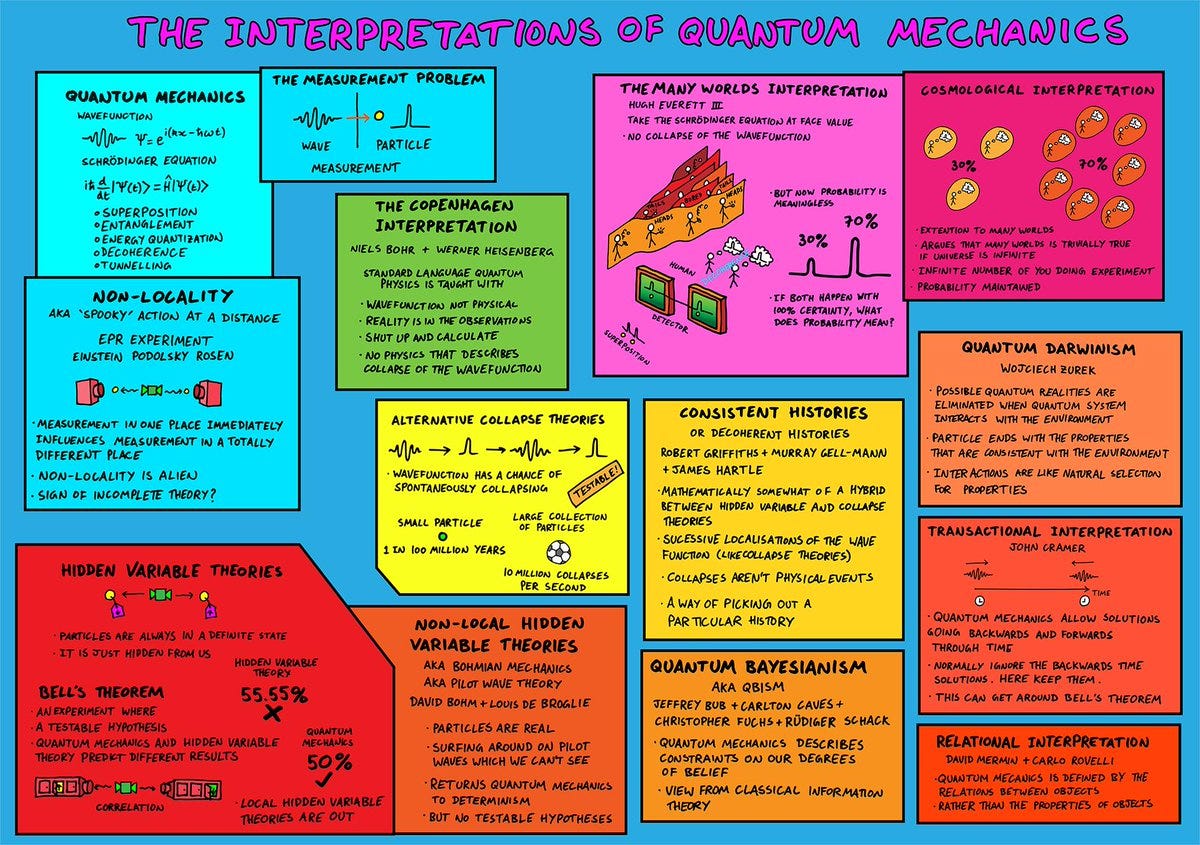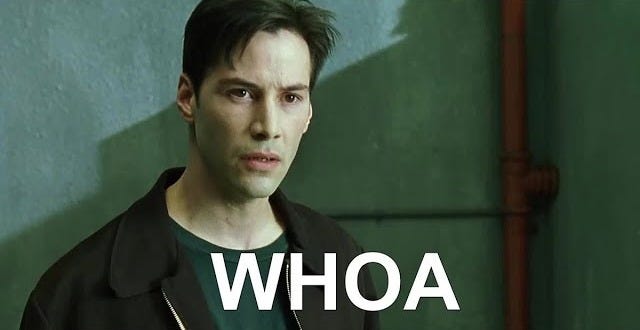Quantum physics is like the Holy Trinity
The more we try to understand it, the less we get it
Quantum physics is a riddle wrapped in a mystery, a paradoxical puzzle that has confounded physicists since its inception. It’s one of the most triumphant branches of science—its mathematics correspond astonishingly well to the physical world—yet it remains an enigma, its “plain sense” meaning hovering well beyond our grasp. Let me paint you a picture to show you what I’m getting at.
Einstein’s general theory of relativity is another modern mathematical marvel describing the world. We don’t struggle to find words for it. In fact, plain sense explanations abound for general relativity: spacetime is like a flexible fabric! a black hole is a literal hole in space! and so on. These images, while not the whole story, give us a mental foothold, something to cling to. Quantum mechanics, though? It’s like trying to hold onto mist. It resists every attempt to be tamed into relatable terms.
Consider the Schrödinger equation, a cornerstone of quantum mechanics. It elegantly charts (in mathematical terms) how a quantum system’s state (its wavefunction) changes with time. But when we try to translate this into human language, we end up saying things like: “A quantum system can exist in multiple states at once until it’s observed.” What does that mean? In plainer words it means something can be two completely different things at once. To picture this, imagine a poodle in a box whose fate hinges on an unobserved quantum event. Until someone looks in the box, that poodle is both alive and dead—a bizarre superposition of possibilities. Only when observed does the wavefunction of the poodle-quantum system “collapse” and the poodle’s reality snaps into one state: alive or dead, but not both.1
Such mind-twisting scenarios are not necessarily what the math of the Schrödinger equation says; it’s what a particular interpretation of the math suggests. Here, the Copenhagen Interpretation—one Erwin Schrödinger himself found unsettling—casts its strange spell. I find other interpretations no less strange.
An interpretation of quantum physics is a human attempt to wrestle its ethereal math into a box we can comprehend, to clothe the unknown in meaning. There are at least a dozen interpretations of quantum physics, none of which are (to me, anyway) relatable in human terms.

No one can quite pin down what the math of quantum physics means. Until recently, I took kind of a free-spirited, hippy stance: Maybe it’s, like, all of them and none of them, man. Nobody really understands quantum physics, so what difference does it make? But then physicist and science communicator Sabine Hossenfelder offered a revelation that shifted my perspective:
We have no good words to describe the maths of quantum physics. Because we need to talk about it somehow, we have come up with phrases like “in two places at once” or “takes all paths at the same time,” or “action at a distance.”
These are all over the popular science literature because it's the best we can do without maths. And I think that they fulfill a purpose in making an abstract topic a little more comprehensible. But they shouldn't be mistaken for a description of reality.
I think that this is to be expected, that as we discover theories about nature which are further removed from our everyday experience, that words literally fail us and maths is what remains.
This is why I don't understand when people say that we don't understand what a particle is or what gravity is because we “only” have a mathematical description. What do they expect? I think having a mathematical description is what it means to understand something. [emphasis added]
This is profound, next-level stuff.
To unravel this, let’s turn to two Renaissance scientists who glimpsed the divine in their work. Galileo’s gift to humanity was to weave mathematics into physics, which led to the unveiling of the physical world’s hidden mathematical order. It wasn’t a given that math would apply to the real world, and yet, miraculously, it did. It was so miraculous that Galileo proclaimed mathematics as the alphabet God used to write the laws of the universe.
Galileo’s contemporary, Johannes Kepler, saw his scientific work as “thinking God’s thoughts after Him.” His breakthrough came when he surrendered his vision of perfect circles for planetary orbits and embraced ellipses—because only ellipses matched the data perfectly. God, it seemed, wrote the laws of nature with stranger, more perplexing mathematics than anyone had dared to dream.
Now, let’s weave these threads together to solve the mystery of quantum mechanics.
Hundreds of years after Galileo and Kepler, we discover the quantum world—a realm so alien to our senses that human words falter and we are “reduced” to mathematical descriptions. Does this lack of words mean we understand less about the world? I’m beginning to doubt that.
It seems the deeper we drill past the strata of the everyday world, the more we unearth the precious minerals of pure knowledge from the ore of human experience. The deeper we go, the more we move past understanding our world on a human level and the more purely we see it in God's terms. Of course this deeper realm seems alien to us—it has to:
“For my thoughts are not your thoughts, neither are your ways my ways,” declares the Lord. “As the heavens are higher than the earth, so are my ways higher than your ways and my thoughts than your thoughts. ...” – Isaiah 55:8-9
Perhaps God offers us a twofold gift with quantum physics. Its mathematics empowers us to understand practical things, all the way from collapsing stars to computers and smartphones. Yet it also draws back the curtain on the physical world, revealing its divine source. Quantum physics may well be the purest harmony of the universe we can discern: we hear God’s beautiful and mysterious music, but the lyrics are beyond our comprehension.
I’ll admit, the hippy in me is transforming into a mystic. I now suspect quantum physics resists human relatability because it’s not meant to be fully grasped in human terms. It’s God’s invitation to witness His hidden handiwork, a fleeting glimpse of the divine machinery beneath reality’s surface.
With this realization, we haven’t so much solved the mystery of quantum physics as glimpsed its divine source.
I see interpretations of quantum physics much like analogies of the Holy Trinity. No one has fully explained the mystery of how one God can be three Persons, so we try to craft relatable analogies. Each falls short, usually committing some form of heresy in the process. While the nature of science precludes the concept of heresy (scientists are supposed to question everything) our attempts to make sense of quantum physics inevitably lead to unsettling absurdities. Maybe we have to accept that there are things beyond our ability to grasp in human terms. Personally, I’m just fine with that.
Related: How to commit heresy using physics (yes, it can be done).
Liked this article? Share it with a friend who’d enjoy the science-and-faith conversation. If you’re a free subscriber who would like to support my work, you can upgrade to a paid subscription (which comes with some perks).
The canonical way to illustrate this absurdity is through a thought experiment called Schrödinger’s cat, which for personal reasons I have changed to Schrödinger’s poodle.




Richard Feynman: “If you think you understand quantum mechanics, you don't understand quantum mechanics.”
Also, “I think I can safely say that no one understands quantum mechanics.”
Richard Feynman, The Character of Physical Law (MIT Press, 1967), p. 129.
I appreciated this article more than I expected when I started reading it. What it unlocked for me is an analogy concerning free-will that I have carried for a long time. If we think of a (geometric) plane that embraces all future possible choices, each choice we make “collapses” (to use the QM idea) all of the possibilities into what is now history. Each set of choices made reduces the possibilities - or probabilities - into an actualized set. The plane behind me has become a series of line segments connecting decision points, while the half plane of possibilities extends beyond me. Watched from outside the plane, it appears on the whole either as a pattern of random interactions or interactions following a law - such as particles in a plasma in an electric field. Each particle reacts mechanistically to its environment (our human nature), but can be moved in a particular direction to a determined end - such as electrons in a cathode tube.
Thank-you for that extra insight.